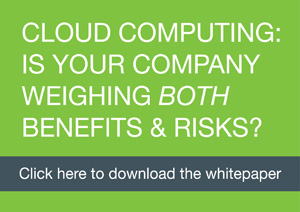Sponsored Content by ACE Group
5 & 5: Rewards and Risks of Cloud Computing

Cloud computing lowers costs, increases capacity and provides security that companies would be hard-pressed to deliver on their own. Utilizing the cloud allows companies to “rent” hardware and software as a service and store data on a series of servers with unlimited availability and space. But the risks loom large, such as unforgiving contracts, hidden fees and sophisticated criminal attacks.
ACE’s recently published whitepaper, “Cloud Computing: Is Your Company Weighing Both Benefits and Risks?”, focuses on educating risk managers about the risks and rewards of this ever-evolving technology. Key issues raised in the paper include:
5 benefits of cloud computing
1. Lower infrastructure costs
The days of investing in standalone servers are over. For far less investment, a company can store data in the cloud with much greater capacity. Cloud technology reduces or eliminates management costs associated with IT personnel, data storage and real estate. Cloud providers can also absorb the expenses of software upgrades, hardware upgrades and the replacement of obsolete network and security devices.
2. Capacity when you need it … not when you don’t
Cloud computing enables businesses to ramp up their capacity during peak times, then ramp back down during the year, rather than wastefully buying capacity they don’t need. Take the retail sector, for example. During the holiday season, online traffic increases substantially as consumers shop for gifts. Now, companies in the retail sector can pay for the capacity they need only when they need it.

3. Security and speed increase
Cloud providers invest big dollars in securing data with the latest technology — striving for cutting-edge speed and security. In fact, they provide redundancy data that’s replicated and encrypted so it can be delivered quickly and securely. Companies that utilize the cloud would find it difficult to get such results on their own.
4. Anything, anytime, anywhere
With cloud technology, companies can access data from anywhere, at any time. Take Dropbox for example. Its popularity has grown because people want to share large files that exceed the capacity of their email inboxes. Now it’s expanded the way we share data. As time goes on, other cloud companies will surely be looking to improve upon that technology.
5. Regulatory compliance comes more easily
The data security and technology that regulators require typically come standard from cloud providers. They routinely test their networks and systems. They provide data backups and power redundancy. Some even overtly assist customers with regulatory compliance such as the Health Insurance Portability and Accountability Act (HIPAA) or Payment Card Industry Data Security Standard (PCI DSS).
 5 risks of cloud computing
5 risks of cloud computing
1. Cloud contracts are unforgiving
Typically, risk managers and legal departments create contracts that mitigate losses caused by service providers. But cloud providers decline such stringent contracts, saying they hinder their ability to keep prices down. Instead, cloud contracts don’t include traditional indemnification or limitations of liability, particularly pertaining to privacy and data security. If a cloud provider suffers a data breach of customer information or sustains a network outage, risk managers are less likely to have the same contractual protection they are accustomed to seeing from traditional service providers.
2. Control is lost
In the cloud, companies are often forced to give up control of data and network availability. This can make staying compliant with regulations a challenge. For example cloud providers use data warehouses located in multiple jurisdictions, often transferring data across servers globally. While a company would be compliant in one location, it could be non-compliant when that data is transferred to a different location — and worst of all, the company may have no idea that it even happened.
3. High-level security threats loom
Higher levels of security attract sophisticated hackers. While a data thief may not be interested in your company’s information by itself, a large collection of data is a prime target. Advanced Persistent Threat (APT) attacks by highly skilled criminals continue to increase — putting your data at increased risk.

4. Hidden costs can hurt
Nobody can dispute the up-front cost savings provided by the cloud. But moving from one cloud to another can be expensive. Plus, one cloud is often not enough because of congestion and outages. More cloud providers equals more cost. Also, regulatory compliance again becomes a challenge since you can never outsource the risk to a third party. That leaves the burden of conducting vendor due diligence in a company’s hands.
5. Data security is actually your responsibility
Yes, security in the cloud is often more sophisticated than what a company can provide on its own. However, many organizations fail to realize that it’s their responsibility to secure their data before sending it to the cloud. In fact, cloud providers often won’t ensure the security of the data in their clouds and, legally, most jurisdictions hold the data owner accountable for security.
The takeaway
Risk managers can’t just take cloud computing at face value. Yes, it’s a great alternative for cost, speed and security, but hidden fees and unexpected threats can make utilization much riskier than anticipated.
Managing the risks requires a deeper understanding of the technology, careful due diligence and constant vigilance — and ACE can help guide an organization through the process.
To learn more about how to manage cloud risks, read the ACE whitepaper: Cloud Computing: Is Your Company Weighing Both Benefits and Risks?
This article was produced by the R&I Brand Studio, a unit of the advertising department of Risk & Insurance, in collaboration with ACE Group. The editorial staff of Risk & Insurance had no role in its preparation.










